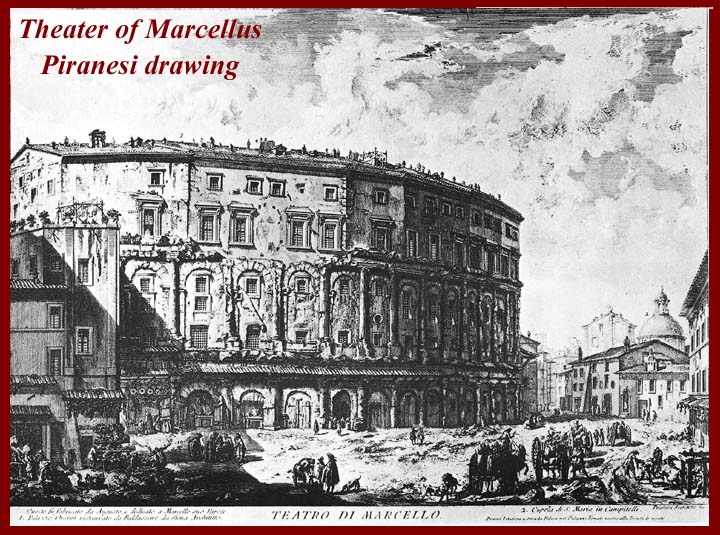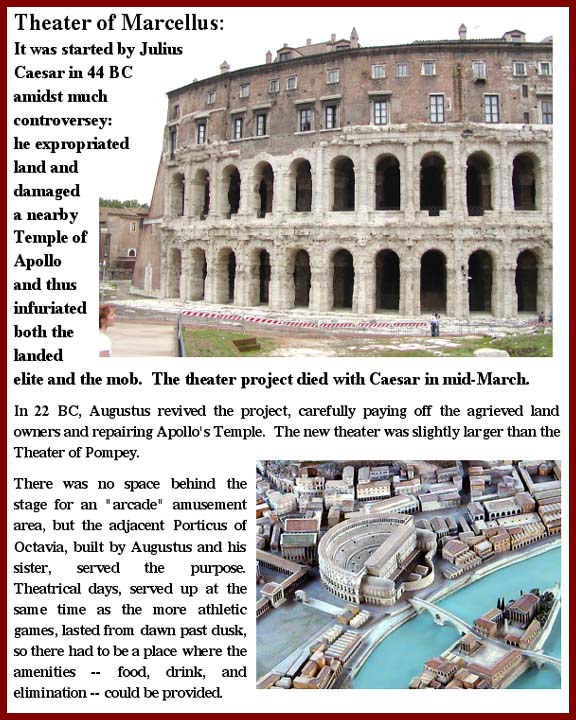Theater of Marcellus/Teatro Marcello


Julius Caesar did a lot of unpopular things in the six months between his return to Rome after his wars and dalliances in the eastern Mediterranean and his assassination on March 15 in 44 BC. One of them certainly was to install Cleopatra -- his most recent dalliance -- in a Janiculum villa, but that didn't really hit the pocketbooks of his rich rivals.Something that did cost them money was his expropriation of land and destruction of buildings near the forum boarium, east of the Tiber River hard by the Tiber Island. Caesar wanted to build a theater to rival the one built by Pompey, whom he had just defeated and killed in the struggle for the control of Rome. Part of the site that he chose had been used at least since 179 BC for dramatic productions in front of a temple of Apollo.
When Caesar was killed, all work on his theater complex stopped, and the site remained in limbo until 22 BC. By then Augustus was seven years into his long rule as princeps, and his plan to transform Rome from a city of brick to a city of marble was already under way. Caesar's theater was a likely project, but Augustus did not want to repeat Caesar's mistake. Using private funds, he expanded the site, making sure that those injured by Caesar's high-handed expropriations 22 years earlier were also compensated. Construction began in 22 BC and by 17 BC, although incomplete, the theater was used for some of the theatrical productions that were part of that year's Ludi Saeculares (secular games). The theater was formally dedicated in 13 BC in memory of Marcellus, the son of Augustus' sister Octavia. Marcellus had died five years before Augustus took up the project, and he was the first of several putative successors that Augustus outlived.
And it was a magnificent structure. Built mainly of tufa, cement, and opus reticulatum brickwork, the Theatrum Marcelli was completely sheathed in white travertine. The semi-circular seating area (the cavea) was 130 meters in diameter and probably rose to a height of about 50 meters, counting all of the superstructure that supported the awnings that shaded the audience. True to Caesar's original plan, it was bigger and more elaborate that Pompey's theater. It seated about 12,000 spectators (maybe 14,000 with standees) which was twenty percent more than would fit into Pompey's theater. (Livy's estimate of 40,000 for Pompey's theater is wildly inaccurate, just as some modern estimates for this theater's capacity are overstated.)
Both in seating capacity and in size the Theater of Marcellus was the largest ever built in the Roman Empire.
The façade of the cavea had three levels, the first and second in arcades with external pilasters (Doric on the ground level and Ionic on the second) and a third with a closed wall and modified Corinthian pilasters. (This arrangement was later copied for the Colosseum by Vespasian, who was trying to demonstrate his cultural, and, therefore, political, continuity with Augustus.) The Corinthian uppermost level is now completely invisible, the sheathing having been used elsewhere and any remaining internal structure built into later superimposed buildings. Only about one third of the two lower levels of the original 44 arches around the exterior of the curve are still visible, and perhaps another third of the curve is substructure for adjoining buildings. None of the statues that occupied the second level arches are in situ. The three tall columns on the brick covered cement platform in front of the facade are not, I've been told, "original equipment" -- they were moved there from the Forum as part of one of Mussolini's programs to enhance the beauty and grandeur of Rome.
The theater had the usual shallow stage with an enormous stone scaena (from which comes the modern theatrical term "scenery") rising behind it to at least the height of the top of the cavea. The exact aspect of the scaena is unknown -- its remains were also buried in later construction -- but, like other Roman theaters in suitable locations, it had openings through which the natural setting -- here, the Tiber Island -- could be seen. The backstage area had only a small portico: nearness to the River, while an asset for scenic effects, limited the area available for audience relaxation. A solid back wall with a large apsidal exedra kept occasional Tiber floods out of the backstage precinct. (Part of this wall has recently been exposed in ongoing archeological excavations.)
Because there was little space backstage, Augustus restored and enlarged a porticus just north of the theater that had been built by Quintus Metellus in 149 BC. The Augustan version of this porticus, renamed for his sister Octavia, was 135 by 115 meters and housed temples, libraries, and public facilities for the use of theater-goers. Augustus stocked the porticus with the best available art and sculpture, including the famous "Medici Venus" which was dug from the rubble during the early renaissance and is now in the Uffizi in Florence. Another important find, a square statue pedestal sculptured in white marble showing four scenes from the life of Hercules was found in 2000.
Over the centuries, the Theater of Marcellus first went through a number of redecorations, restorations, and repairs (Nero, Vespasian, Alexander Severus, and others), and later it was turned to other uses. By the 12th century it had fallen into private hands and the Favvi family ("Fabii" in Latin) were busily turning it into a medieval fortress. The Savelli family took possession in 1368 and early in the 16th century they commissioned Baldassare Peruzzi to build the Palazzo that still stands on the scaena and the visible part of the cavea. It became an Orsini property in 1712. Other buildings gradually accreted and commingled to make the pile what it is today, a multilevel structure, still recognizable as an imperial Roman theater, but with intermediate levels and topped by modernized luxury apartments. While all this building was going on, the site was also subjected to some serious "de-construction" -- much of what is missing today can be seen in other Roman structures, including the nearby Cestian Bridge to the Tiber island, which was restored using Teatro Marcello travertine blocks in 370 AD.
Internet links:
The archtypical Internet description, from the Platner and Ashby Topographical Dictionary: http://efts.lib.uchicago.edu/cgi-bin/eos/eos_page.pl?DPI=100&callnum=DG16.P72&ident=513 (scroll down past the description of the Balbi Theater, and then use arrows to continue on two subsequent pages.)
3d visualisations at Ancient Sites:
http://australis.www2.50megs.com/Marcellus/tour1a.HTMLMuseum of Roman Civilization (EUR, Rome) model showing the Theater's prime location: http://www.vroma.org/images/mcmanus_images/marcellustheater.jpg
A large-scale ground plan is at http://www.geocities.com/Athens/Pantheon/9013/Pics/marc28.gif
A collection of images of the ruins: http://www.giovannirinaldi.it/page/rome/romamarcello/
P.S.:
1. Curtain Up? No, Curtain DOWN! In Roman and Greek theaters, there was a great curtain that angled from the top of the scaena toward the front of the stage. As the orchestra (musicians sitting in the semi-circular area between the stage and the lowest row of seats, called, of all things, the "orchestra")started the overture, the curtain was let down into a long slot where it was wound around a spindle under the front edge of the wooden stage. The curtain went back UP at the end of the drama using counter-weighted ropes around drums or capstans.2. High tech sound systems. It's often been said that the curved arrangement of ancient theaters made sound enhancement unnecessary. Just goes to prove that what's often said ain't necessarily so. The uneven and sometimes draped scaena was not a very good sound reflector and speakers were not at the focus of parabolic reflectors -- the false theory often put forth. Speakers just had to be loud or to have mechanical help. The old wooden theaters were pretty resonant, especially if you put in a thin closed wall around behind the top row of seats. The bigger and newer stone theaters did not resonate well, however, and thousands of closely packed bodies, swathed mostly in wool, resonated not at all. But the Romans, borrowing from the Greeks, knew a lot about sound -- for example, they knew that it propagated through the air as pressure waves which could be augmented by cleverly installed resonators. In classy theaters, these were accurately sized hemispherical bronze or, better still, brass bowls that pointed back toward the center of the stage from acoustically isolated mountings below and behind the ranks of seats. The Marcellus theater had, according to contemporary accounts, more than 40 such resonators. These would now be called "Helmholz resonators" after the German scientist who derived their mathematical principles in the late 19th century. Helmholz resonators are used today in musical instruments (all the classical strings and some others), in home music systems ("tuned-port" bass-reflex cabinets), tiny ones in hearing aids, and some really big ones in theaters, opera houses, and orchestral recording studios. You may even have been inside one -- think of those roaring resonant crescendos that suddenly overwhelm you inside roofed sports arenas.
To see the amazing extent of Roman knowledge about sound, go to http://penelope.uchicago.edu/Thayer/E/Roman/Texts/Vitruvius/5*.html and scroll down to Chapter 5 to read what Vitruvius wrote, at about the same time the Theater of Marcellus was built, about theater sound and acoustics and how to size and install (Helmholz) resonators. The other chapters in this section of Vitruvius are concerned with additional aspects of theater location and design and with voice and music theory.